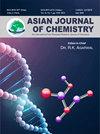异丙醇混合溶剂对十六烷基三甲基溴化铵与溴甲酚绿相互作用的影响:电导率研究
Q4 Chemistry
引用次数: 0
摘要
本研究采用电导法研究了阴离子染料溴甲酚绿(BCG)与阳离子表面活性剂十六烷基三甲基溴化铵(CTAB)的相互作用。研究了将溶剂介质从水改为共溶剂异丙醇的影响,以及实验温度升高对 BCG-CTAB 体系结合行为的影响。观察到的 CMC 和 ΔG°m 值表明 CTAB 系统在异丙醇中不利于胶束化。而在有 BCG 作为添加剂的情况下,CTAB 的胶束化是有利的。BCG-CTAB 系统在异丙醇中更容易胶束化。根据观察到的 ΔH°m 和 ΔS°m 值,可以预测 CTAB 在水溶液中的胶化过程是内热和熵驱动的,而在 BCG 存在的情况下,胶化过程则是放热和焓驱动的。在异丙醇中,BCG-CTAB 系统的胶束化过程是放热和焓驱动的。计算得出的 BCG-CTAB 系统在不同温度下从水介质向水-异丙醇介质转移的热力学参数(ΔG°m,tr、ΔH°m,tr、ΔS°m,tr)也支持 BCG-CTAB 系统胶化过程中的熵焓互作。本研究还发现,在 CTAB 和 BCG-CTAB 系统的胶合过程中,胶化焓和胶化熵之间存在补偿现象。疏水稳定作用导致 BCG-CTAB 系统在水中胶化的自发性增加,而在异丙醇存在下疏水稳定作用减弱,胶化的自发性降低。本文章由计算机程序翻译,如有差异,请以英文原文为准。
Effect of Isopropanol Mixed Solvent on Interaction of Cetyltrimethylammonium Bromide with Bromocresol Green: A Conductometric Study
In present work, the interaction of an anionic dye, bromocresol green (BCG) with a cationic surfactant, cetyltrimethylammonium bromide (CTAB), was studied using conductometric method. The effect of alteration of solvent media from water to cosolvent isopropanol and the effect of elevation in experimental temperature on the association behaviour of BCG-CTAB system were studied. The observed CMC and ΔG°m values indicate disfavored micellization of CTAB system in isopropanol. Whereas micellization of CTAB is favoured in the presence of BCG as additive. For BCG-CTAB system micellization becomes more feasible in presence of isopropanol. The observed value of ΔH°m and ΔS°m predicts micellization of CTAB is endothermic and entropy driven in aqueous solution, whereas, in the presence of BCG it becomes exothermic and enthalpy driven. The micellization process of BCG-CTAB system is exothermic and enthalpy driven in isopropanol. The calculated thermodynamic parameters of transfer for the BCG-CTAB system from water to water-isopropanol media at various temperatures (ΔG°m,tr, ΔH°m,tr, ΔS°m,tr) also supports the entropy-enthalpy mutual act in the micellization process of BCG-CTAB system. Present study also reveals that a compensation phenomenon is operative between the enthalpy and entropy of micellization in case of association process involving the CTAB and the BCG-CTAB systems. The hydrophobic stabilization results to increase in spontaneity of micellization of BCG-CTAB system in water while there is a decrease in hydrophobic stabilization in the presence of isopropanol and a decrease in spontaneity of micellization.
求助全文
通过发布文献求助,成功后即可免费获取论文全文。
去求助
来源期刊

Asian Journal of Chemistry
化学-化学综合
CiteScore
0.80
自引率
0.00%
发文量
229
审稿时长
4 months
期刊介绍:
Information not localized
 求助内容:
求助内容: 应助结果提醒方式:
应助结果提醒方式:


